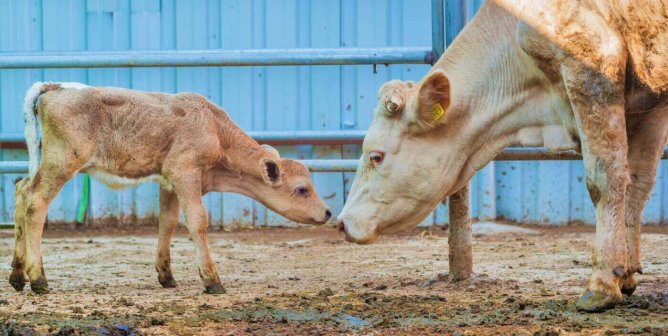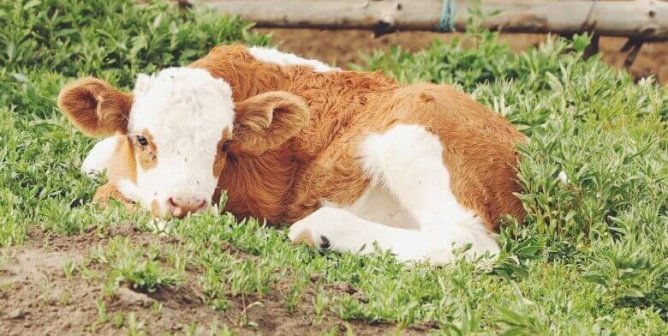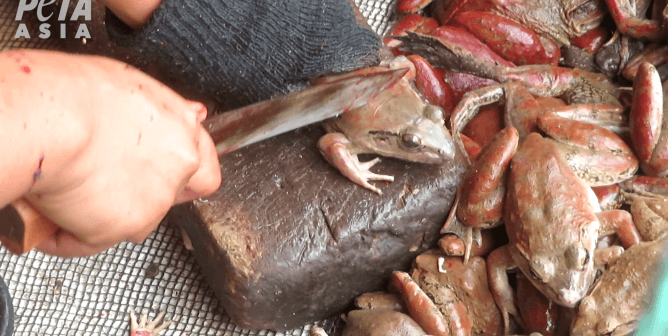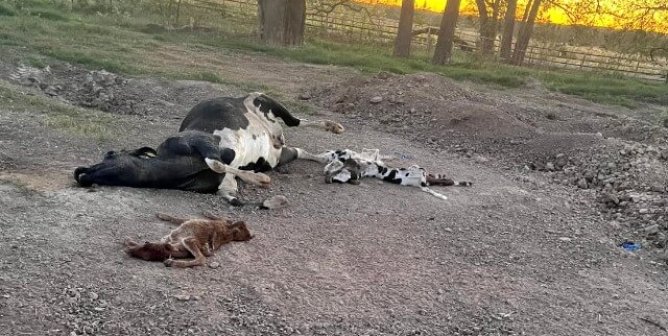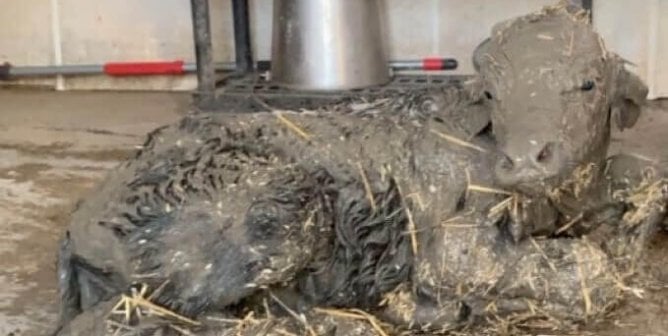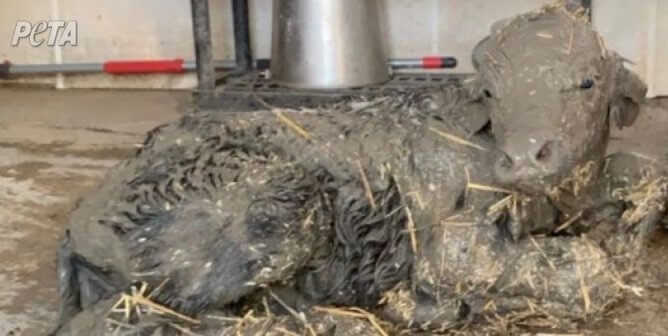Veganism and the Environment
Raising animals for food requires massive amounts of land, food, energy, and water. The byproducts of animal agriculture pollute our air and waterways. By shunning animal products, vegans are de facto environmentalists.
Using Up Resources
As the world’s appetite for meat increases, countries across the globe are bulldozing huge swaths of land to make more room for animals as well as crops to feed them. From tropical rain forests in Brazil to ancient pine forests in China, entire ecosystems are being destroyed to fuel humans’ addiction to meat. According to scientists at the Smithsonian Institution, seven football fields’ worth of land is bulldozed every minute to create more room for farmed animals and the crops that feed them.1 Of all the agricultural land in the U.S., 80 percent is used to raise animals for food and grow grain to feed them—that’s almost half the total land mass of the lower 48 states.2 In the “finishing” phase alone, in which pigs grow from 100 pounds to 240 pounds, each hog consumes more than 500 pounds of grain, corn, and soybeans; this means that across the U.S., pigs eat tens of millions of tons of feed every year.3
Chickens, pigs, cattle, and other animals raised for food are the primary consumers of water in the U.S.: a single pig consumes 21 gallons of drinking water per day, while a cow on a dairy farm drinks as much as 50 gallons daily.4,5 It takes more than 2,400 gallons of water to produce 1 pound of cow flesh, whereas it takes about 180 gallons of water to make 1 pound of whole wheat flour.6
Polluting the Air
Carbon dioxide, methane, and nitrous oxide together cause the vast majority of global warming. Producing a little more than 2 pounds of beef causes more greenhouse-gas emissions than driving a car for three hours and uses up more energy than leaving your house lights on for the same period of time.7 According to the United Nations, a global shift toward a vegan diet is vital if we are to combat the worst effects of the climate crisis.8
Factory farms also produce massive amounts of dust and other contaminates that pollute the air. A study in Texas found that animal feedlots in that state produce more than 7,000 tons of particulate dust every year and that the dust “contains biologically active organisms such as bacteria, mold, and fungi from the feces and the feed.”9 And when the cesspools holding tons of urine and feces get full, factory farms may circumvent water pollution limits by spraying liquid manure into the air, creating mists that are carried away by the wind and inhaled by nearby residents.10 According to a report by the California State Senate, “Studies have shown that [animal waste] lagoons emit toxic airborne chemicals that can cause “inflammatory, immune, … and neurochemical problems in humans.”11
The Environmental Protection Agency (EPA) reports that roughly 80 percent of ammonia emissions in the U.S. come from animal waste.12 A California study found that a single dairy cow “emits 19.3 pounds of volatile organic compounds per year, making dairies the largest source of the smog-making gas, surpassing trucks and passenger cars.”13
Polluting the Water
Each day, factory farms produce billions of pounds of manure, which ends up in lakes, rivers, and drinking water.
The one trillion pounds of waste produced by factory-farmed animals each year are usually used to fertilize crops, and they subsequently end up running off into waterways—along with the drugs and bacteria that they contain.14 Many tons of waste end up in giant pits in the ground or on crops, polluting the air and groundwater. According to the EPA, agricultural runoff is the number one source of pollution in our waterways.15
It doesn’t stop there. Streams and rivers carry excrement from factory farms to the Mississippi River, which then deposits the waste in the Gulf of Mexico. The nitrogen from animal feces—and from fertilizer, which is primarily used to grow crops for farmed animals—causes algae populations to skyrocket, leaving little oxygen for other life forms. A 2006 report by the National Oceanic and Atmospheric Administration found that the Gulf of Mexico’s “dead zone”—an area in which virtually all the sea animals and plants have died—is now half the size of Maryland.16 In 2006, a separate study by Princeton University found that a shift away from meat production—as well as Americans’ adoption of vegetarian diets—would dramatically reduce the amount of nitrogen in the Gulf to levels that would make the dead zone “small or non-existent.”17
Cruelty to Animals
In addition to polluting the environment, factory farming strives to produce the most meat, milk, and eggs as quickly and cheaply as possible and in the smallest amount of space possible, resulting in abusive conditions for animals. Cows, calves, pigs, chickens, turkeys, ducks, geese, rabbits, and other animals are kept in small cages or stalls, where they are often unable to turn around. They are deprived of exercise so that all their energy goes toward producing flesh, eggs, or milk for human consumption. They are fed drugs that fatten them more quickly, and they are genetically manipulated to grow faster or produce much more milk or eggs than they would naturally. For more industry-specific information, please see our factsheets about pigs, cows, veal, chickens, turkeys, and foie gras.
Don’t be fooled by products labeled as “organic” or “free-range.” Because definitions and enforcement of regulations are inconsistent, it’s difficult to determine which products actually come from animals who are treated decently. Since none of the labels applies to transport or slaughter and none prohibits bodily mutilations such as debeaking, tail-docking, ear-notching, or dehorning, the worst cruelty continues to be completely unregulated. For more information, please see our factsheet about these misleading labels.
What You Can Do
Switching to a vegan diet reduces your “ecological footprint,” allowing you to tread lightly on the planet and be compassionate to its inhabitants. With so many great vegan options, eating green has never been more delicious. Whether you go vegetarian for the environment, for your health, or for animals, you have the power to change the world, simply by changing what’s on your plate.
References
1Smithsonian Institution, “Smithsonian Researchers Show Amazonian Deforestation Accelerating,” Science Daily 15 Jan. 2002.
2Marlow Vesterby and Kenneth S. Krupa, “Major Uses of Land in the United States, 1997,” Statistical Bulletin No. 973, U.S. Department of Agriculture, 1997.
3John Carlson, “Evaluation of Corn Processing By-Products in Swine Diets,” Western Illinois University, 3 Apr. 1996.
4Theo van Kempen, “Whole Farm Water Use,” North Carolina State University Swine Extension, Jul. 2003.
5Rick Grant, “Water Quality and Requirements for Dairy Cattle,” NebGuide, Cooperative Extension, Institute of Agriculture and Natural Resources, University of Nebraska-Lincoln, 1996.
6Marcia Kreith, “Water Inputs in California Food Production,” Water Education Foundation 27 Sept. 1991.
7Daniele Fanelli, “Meat Is Murder on the Environment,” New Scientist 18 Jul. 2007.
8International Panel for Sustainable Resource Management, “Assessing the Environmental Impacts of Consumption and Production,” United Nations Environment Programme 2010.
9Consumers Union SWRO, “Animal Factories: Pollution and Health Threats to Rural Texas,” May 2000.
10Jennifer Lee, “Neighbors of Vast Hog Farms Say Foul Air Endangers Their Health,” The New York Times 11 May 2003.
11Kip Wiley et al., “Confined Animal Facilities in California,” California State Senate, Nov. 2004.
12State of North Carolina, Department of Environment and Natural Resources, “Review of Emission Factors and Methodologies to Estimate Ammonia Emissions From Animal Waste Handling,” U.S. Environmental Protection Agency, Apr. 2002.
13Jennifer M. Fitzenberger, “Dairies Gear Up for Fight Over Air,” Fresno Bee 2 Aug. 2005.
14R.S. Dungan, ” Board-Invited Review: Fate and Transport of Bioaerosols Associated with Livestock Operations and Manures,” Journal of Animal Science,” 88(2010): 3693-3706.
15U.S. Senate Committee on Agriculture, Nutrition, and Forestry.
16“NOAA Forecasts Larger Than Normal ‘Dead Zone’ for Gulf This Summer,” NOAA News Online, 24 Jul. 2006.
17Simon D. Donner, “Surf or Turf: A Shift From Feed to Food Cultivation Could Reduce Nutrient Flux to the Gulf of Mexico,” Global Environmental Change 17 (2007): 105-13.
